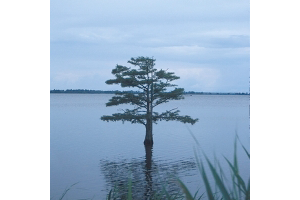Taxodium is from a Greek word meaning “yew-like;” distichum means “two-ranked” and refers to the leaves. The bark of the bald cypress has been used to make cords and ropes. Because the wood is highly resistant to rot, it is valuable and used to construct structures that are exposed to wet conditions. Some bald cypress trees in the southern U.S. have been reported to be 1,200 years old. The bald cypress is listed as threatened in the state of Indiana. Taxodium distichum is native to the U.S. and is in the Cupressaceae (cypress) family.
Photo Credit: © John J. Mosesso http://life.nbii.gov
Taxodium distichum
Common Name: bald cypress
Other Common Names: baldcypress
Other Scientific Names: Taxodium ascendens
Plant Functional Group: Deciduous conifer
Class > Order > Family: Pinopsida > Pinales > Cupressaceae
What does the species look like?
Taxodium distichum is a perennial, deciduous, coniferous tree that can reach 100 to 150 feet in height. The crown of the tree is irregular, broad, and spreading. The branches are brown, and often covered with gray Spanish moss. The bark of the bald cypress is brown, thin, and fibrous, and often peels in strips. Leaves are needlelike, pale green, and turn an orangish-brown before they drop in the fall. Blooms are purple and are monoecious with separate male (pollen) and female (seed) cones. Mature trees develop brown seed cones with scales near the end of their branches. Bald cypress also develops root-like "knees" when grown in wet areas.
Bald cypress usually grows in wetlands along running streams, lakes, and swamps with clayey or fine sandy soils at elevations about 100 feet above sea level. It prefers sun, but can tolerate some shade. Bald cypress can also tolerate cold conditions.
The seeds of bald cypress are eaten by wild turkey, wood ducks, grosbeaks, and squirrels. Other bird species use the branches of bald cypress for foraging. Some species of birds, including bald eagles, use the tops of the tree for nesting. Bald cypress is also the larval host for the baldcypress sphinx moth.
Where is the species found?
States & Provinces
AL, AR, DE, FL, GA, IL, IN, KY, LA, MD, MO, MS, NC, NJ, NY, OH, OK, PA, SC, TN, TX, VA, WV
Special Considerations for Observing
This species has separate male (pollen) and female (seed) cones.
Which phenophases should I observe?
Do you see...?
Needles
Breaking needle buds More...
How many buds are breaking?
Less than 3 3 to 10 11 to 100 101 to 1,000 1,001 to 10,000 More than 10,000
Needles More...
What percentage of the potential canopy space is full with needles? Ignore dead branches in your estimate of potential canopy space.
Less than 5% 5-24% 25-49% 50-74% 75-94% 95% or more
Colored needles More...
What percentage of the potential canopy space is full with non-green needle color? Ignore dead branches in your estimate of potential canopy space.
Less than 5% 5-24% 25-49% 50-74% 75-94% 95% or more
Falling needles More...
Pollen cones
Pollen cones More...
How many fresh pollen cones are present?
Less than 3 3 to 10 11 to 100 101 to 1,000 1,001 to 10,000 More than 10,000
Open pollen cones What percentage of all fresh pollen cones (unopened plus open) on the plant are open?
Less than 5% 5-24% 25-49% 50-74% 75-94% 95% or more
Pollen release More...
How much pollen is released?
Little: Only a few grains are released. Some: Many grains are released. Lots: A layer of pollen covers your palm, or a cloud of pollen can be seen in the air when the wind blows
Seed cones
Unripe seed cones Taxodium distichum , an unripe seed cone is green, grayish or brown with scales closed together.More...
How many seed cones are unripe?
Less than 3 3 to 10 11 to 100 101 to 1,000 1,001 to 10,000 More than 10,000
Ripe seed cones Taxodium distichum , a seed cone is considered ripe when it has turned brown and the scales have begun to spread apart to expose the seeds inside. Do not include empty cones that have already dropped all of their seeds.More...
How many seed cones are ripe?
Less than 3 3 to 10 11 to 100 101 to 1,000 1,001 to 10,000 More than 10,000
Recent cone or seed drop More...
How many seed cones have dropped seeds or have completely dropped or been removed from the plant since your last visit?
Less than 3 3 to 10 11 to 100 101 to 1,000 1,001 to 10,000 More than 10,000
What do these phenophases look like?
The following Phenophase Photo Guides for this species have been vetted for accuracy by the USA-NPN National Coordinating Office. Most photo guides are developed for a particular local or regional monitoring effort, and some of the content may not apply to your effort or your region. However, we make them available to provide as much help as they may in illustrating phenophases for this species. If you have high quality phenophase photos that you are willing to share with us, please visit the Phenophase Photo Guidelines page.
Be aware there is variation from individual to individual within a species, especially across different regions, so your plant may not look exactly like the one pictured.
Since they do not always include complete definitions for the species, use these photo guides ONLY in conjunction with the official Nature's Notebook phenophase defintions included in the table above, in the phenophase definition sheet that downloads with the datasheet, or in the Observe screen in the mobile app.
